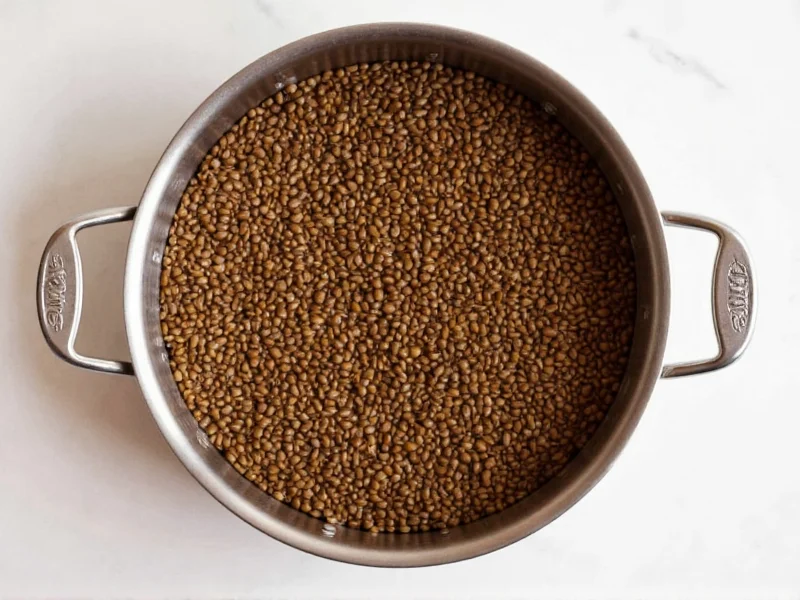Mastering lentil cooking opens doors to nutritious, protein-packed meals that can anchor soups, salads, and side dishes. Unlike many legumes, lentils require no soaking, making them one of the quickest pulses to prepare from dry. Understanding the subtle differences between lentil varieties ensures you achieve the ideal texture for your specific recipe, whether you're making a hearty stew or a delicate dal.
Understanding Lentil Varieties and Their Cooking Needs
Lentils come in several varieties, each with unique cooking properties. Choosing the right type for your dish prevents disappointing results like mushy salads or undercooked stews. The main varieties differ in cooking time, texture retention, and flavor profile.
| Lentil Type | Color/Appearance | Cooking Time | Best Uses | Water-to-Lentil Ratio |
|---|---|---|---|---|
| Brown Lentils | Olive brown, speckled | 20-30 minutes | Hearty soups, stews, shepherd's pie | 1:2.5 |
| Green Lentils | Speckled green, firm | 25-30 minutes | Salads, side dishes, French cuisine | 1:2.5 |
| Red/Yellow Lentils | Orange to golden yellow | 15-20 minutes | Dals, curries, purees, thick soups | 1:3 |
| Black (Beluga) | Small, shiny black | 25-30 minutes | Caviar substitute, salads, pilafs | 1:2.5 |
| Puy Lentils | Dark green with gray spots | 25-30 minutes | Salads, gourmet dishes | 1:2.5 |
Essential Preparation Steps Before Cooking Lentils
Proper preparation ensures consistent results and prevents unpleasant surprises in your finished dish. Many home cooks skip these critical steps, leading to inconsistent cooking or finding small stones in their meal.
Sorting: Spread lentils in a single layer on a light-colored surface and remove any debris, stones, or discolored lentils. This simple visual inspection takes less than two minutes but prevents potential dental disasters.
Rinsing: Place sorted lentils in a fine-mesh strainer and rinse thoroughly under cold running water. Swirl them with your fingers to remove dust and any remaining impurities. Unlike beans, lentils don't require soaking, but rinsing removes surface starches that can cause foaming during cooking.
Step-by-Step Guide to Perfectly Cooked Lentils
Follow this reliable method for consistently well-cooked lentils regardless of variety. This technique works whether you're using a standard pot, Dutch oven, or slow cooker for lentils.
- Measure ingredients: Use 1 cup dried lentils to 2.5-3 cups liquid (water or broth). Red lentils need more liquid (1:3 ratio) as they break down more.
- Combine in pot: Place rinsed lentils and cold liquid in a medium saucepan. Add aromatics like bay leaves, garlic, or onions if desired, but avoid acidic ingredients (tomatoes, vinegar) until after cooking.
- Bring to boil: Increase heat to high and bring to a rolling boil. Skim off any foam that forms on the surface during the first few minutes.
- Simmer gently: Reduce heat to low, maintaining a gentle simmer. Cover partially with a lid to prevent boil-overs while allowing steam to escape.
- Check for doneness: Begin testing 5 minutes before expected cooking time. Lentils should be tender but still hold their shape (except red/yellow varieties which naturally become soft).
- Add seasoning: Stir in salt and acidic ingredients only after lentils are fully cooked to prevent toughening.
- Drain excess liquid: If using the absorption method, any remaining liquid should be minimal. Drain only if necessary, reserving the nutrient-rich cooking liquid for soups.
Avoiding Common Lentil Cooking Mistakes
Even experienced cooks sometimes make these preventable errors that compromise lentil texture and flavor. Understanding these pitfalls helps you achieve restaurant-quality results at home.
Adding salt too early: Salt added at the beginning can cause lentils to become tough and extend cooking time significantly. Wait until lentils are nearly tender before seasoning.
Using acidic ingredients prematurely: Tomatoes, vinegar, or lemon juice added too early prevent lentils from softening properly. Add these only during the last 10 minutes of cooking.
Overcooking for the intended use: Different dishes require different textures. For salads, undercook slightly as lentils continue softening off-heat. For soups and dals, cook until fully tender.
Not adjusting for altitude: At higher elevations, increase cooking time by 15-25% and use slightly more liquid to compensate for lower boiling points.
Flavor Enhancements and Cooking Variations
Transform basic cooked lentils into memorable dishes with these simple techniques that build flavor without complicated steps. These methods work whether you're preparing a quick weeknight meal or planning a special dinner.
Aromatic base: Sauté onions, carrots, and celery in olive oil before adding lentils and liquid. This creates a flavor foundation similar to mirepoix in French cuisine. For Indian-inspired dishes, use cumin seeds, mustard seeds, and curry leaves.
Layering spices: Add whole spices like bay leaves, cinnamon sticks, or cardamom pods during cooking, then finish with ground spices after cooking for brighter flavor. Turmeric works well added during cooking for color and subtle flavor.
Finishing touches: Stir in fresh herbs, a squeeze of lemon juice, or a drizzle of good-quality olive oil just before serving. For creamier textures without dairy, blend a small portion of cooked lentils and stir back into the pot.
Storing and Using Cooked Lentils
Proper storage extends the life of cooked lentils while maintaining texture and flavor. Knowing how to repurpose leftovers prevents food waste and simplifies meal planning throughout the week.
Refrigeration: Store cooled lentils in an airtight container with some cooking liquid for up to 5 days. The liquid prevents drying and maintains texture. Drain excess liquid before using in salads.
Freezing: Freeze cooked lentils in portion-sized containers or freezer bags with ½ cup cooking liquid for up to 6 months. Thaw overnight in the refrigerator or add frozen directly to soups and stews.
Reviving leftovers: Gently reheat lentils with a splash of water or broth to restore moisture. Avoid microwaving on high power, which can create uneven heating and cause some lentils to burst.











 浙公网安备
33010002000092号
浙公网安备
33010002000092号 浙B2-20120091-4
浙B2-20120091-4